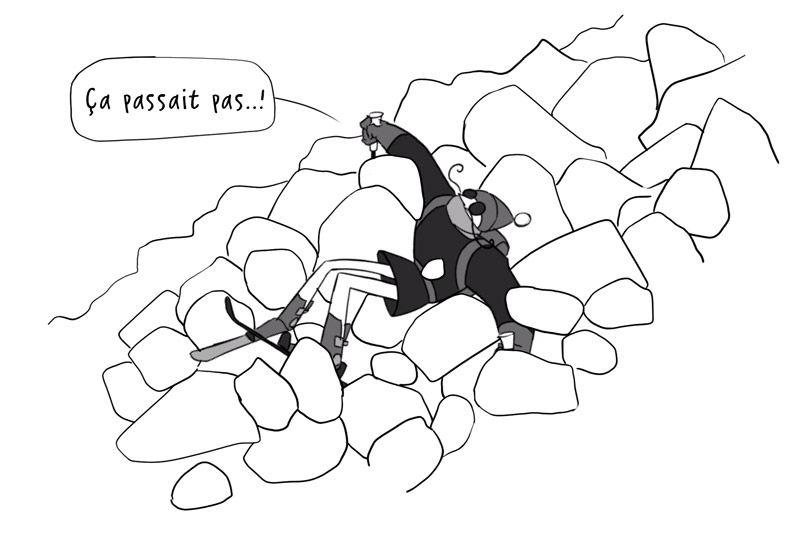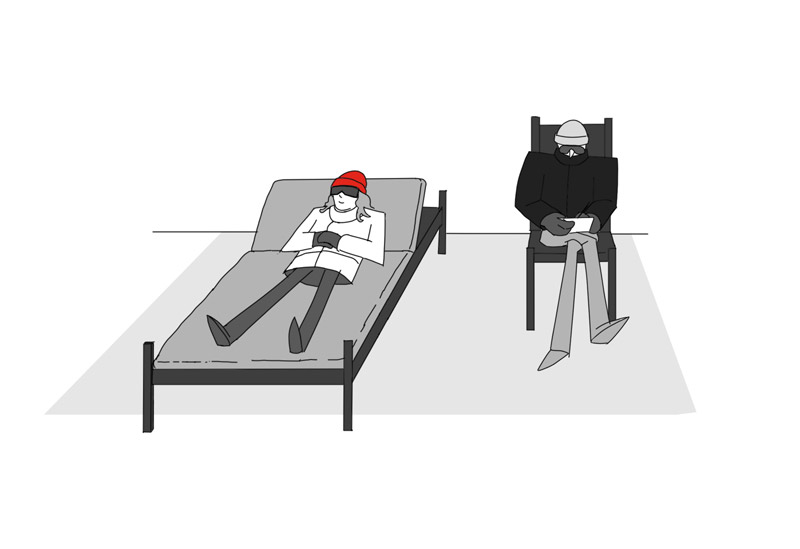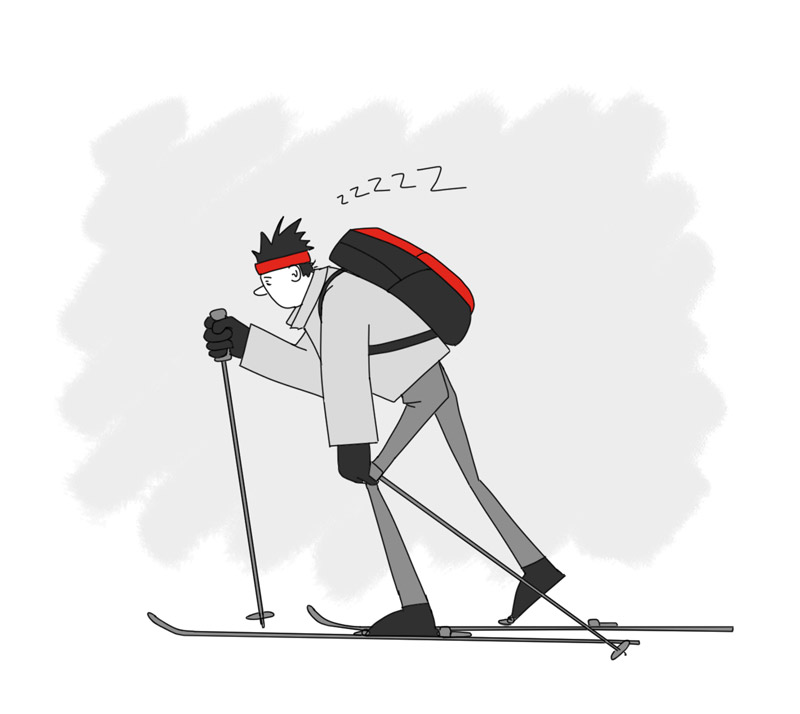HUMAN FACTORS: IN THE FIELD
ONCE IN THE FIELD, EVERYONE’S STATE OF MIND AND PERCEPTION OF THE SITUATION SHOULD BE TAKEN INTO ACCOUNT. TIME SHOULD BE SET ASIDE TO FOCUS, ANALYZE THE SITUATION, AND MAKE THE RIGHT DECISIONS.

Intuition is an often risky method to use for making key decisions in the complex mountain environment.
Intuition calls upon the subconscious part of the brain, offering an energy-saving shortcut. This works well in a stable, well-known environment where routine is the norm. However, intuition does not work well in an environment as unpredictable as snow-covered mountains.
To quote the Swiss high-mountain guide, Werner Munter: «First, I listen to my gut. If it says no, I don’t go. If it says okay, go ahead, that’s when I start to think and use my brain!». In other words, you can listen to intuition when it says no or to turn around. But when your gut says, “go ahead,” you need to activate that logical part of your brain to start thinking and analyzing the situation. The requires stopping at key decision-making points to take the time to think about the situation.
Group intuition based on past experience can cloud thinking, especially in the specific case of avalanche danger, when basing decisions on an accumulation of potentially poor assessments and decisions without consequences.
For example, take a situation where the fourth person in the group triggers an avalanche. If the fourth person had not been on the outing and therefore the avalanche had not been triggered, would the group have considered their decision to cross the slope a good one?
In these circumstances, without any real perspective or feedback on one’s decision-making ability in the field, the skier often accumulates experience based on “false positives”.


Another subconscious trap is “familiarity,” which can lead the skier to continue out of habit or routine without taking time to observe and assess the conditions on a given day. The familiarity trap applies to a location as well as to the regular habits of a specific group. This may lead to poor preparation, especially with regard to terrain observations or the human factors linked heading out into the backcountry or sidecountry with the same group of people time after time. Such thoughts as “We ski here often,” or “These are my regular backcountry partners,” often create a mindset where we fail to question any choices or decisions even when the situation on the day of the outing has probably changed.
A powder day, the ideal weather to reach the summit, a route or descent that you have been waiting to do for years… This situation heavily influences the decisions we make and can easily lead to an accident. Does the desire for first tracks “at any cost” or to reach an objective “at any cost” dictate the decisions we make? We often attribute an extremely higher value to rare or “scarce” events or conditions. In these cases the skier is pushed to seize the opportunity, almost goaded to race to get first tracks in all that new, deep, light powder, to push further and further off-piste or into the backcountry looking for untracked snow. In this quest, the skier sometimes ventures onto dangerous, loaded slopes. The “race for first tracks” is a common phenomenon at ski areas. Areas with easy lift access get tracked out quickly, and by the end of the morning no untracked snow remains. Skiers in search of deep, untracked powder start venturing towards those areas less-frequently skied, and onto slopes with few or no tracks that are more likely contain persistent unstable layers.


The presence of other groups or other tracks can influence decision making. The “social facilitation” effect and worrying about how one is perceived relative to another group can lead to disregarding the rules the group established for the outing. The risk taking would not likely have occurred without the presence of another group. This is the “we’ll show them” trap.
Remember that your brain does not like to think too much due to the energy required. We prefer by default to rely upon what is already there. For example, the temptation to follow existing tracks is always high. This should not stop us from asking the right questions relative to the group we are with and the snow/weather conditions we are facing.
It is important for the group members to get along well and feel comfortable expressing any doubts or concerns they may have. In many avalanche accidents, members of the group had doubts but were afraid to express them out of fear of disappointing the group, causing frustration, or simply due to lack of confidence in their knowledge. Goodwill within the group, listening to others, creating an atmosphere where everyone feels free to express their fears or opinions, and a non-hierarchical relationship between group members are all important elements to facilitate good communication. Trust is necessary to make the right choices for the group as a whole.
The “expert halo” often discourages group members from expressing their doubts. The image the group has of the leader, whether justified or not, can limit a participant’s willingness to use their critical thinking skills.

Turning around is often perceived as a failure, especially on an outing with a single objective. In addition, society places high value on perseverance and our collective “super heroes”. So the skier, moving through an environment as unstable and uncertain as the mountains when covered in snow, is vulnerable.
The decision to turn around simply means adapting to the situation as new information and new parameters appear; it requires every individual in the group to reconsider earlier decisions. A new opportunity now emerges. This means choosing the safety of the group over fun or any other motivation.
Even pro riders and well-known high-mountain guides turn around when facing danger. Behind the fantastic photos and video are often several aborted attempts where they turned around due to unstable conditions or a dangerous situation. On our U-Turn page, read through a series of interviews with the pros where they talk about making the decision to turn around when faced with unexpected or risky conditions.
Estimating the time an outing will take plays a key part of planning a tour. The timing depends on the fitness level and experience of the “weakest” member of the group. The time a tour takes will often change all throughout the outing.
Here are a few rules of thumb to keep in mind (without long breaks) with regard to speed:
- an ascent rate of 400 meters (1300 feet) per hour for the average fit backcountry skier.
- flat sections: 4-5 km (2.5-3 miles) per hour
- ski descents: 2 to 3 times faster than on the ascent if the terrain is easily skiable for the entire group.
Once in the field, taking longer than expected can be a good reason to turn around. For example, in the spring, the avalanche risk increase as the day warms. Also, returning to the starting point “at night” in complicated, avalanche-prone terrain often means losing your frame of reference and finding yourself in a situation where it is difficult or even impossible to choose an alternate route.

